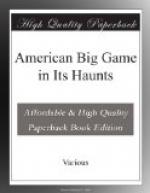The old world elk is still found in some of the large game preserves of eastern Germany, where the Emperor, with his somewhat remarkable ideas of sportsmanship, annually adds several to his list of slaughtered game. They are comparatively abundant in Scandinavia, especially in Norway, where they are preserved with great care. They still survive in considerable numbers in Russia and Siberia as far east as Amurland.
Without going into a detailed description of the anatomical differences between the European elk and the American moose, it may be said that the old world animal is much smaller in size and lighter in color. The antlers are less elaborate and smaller in the European animal, and correspond to the stage of development reached by the average three-year-old bull of eastern Canada. There is a marked separation of the main antler and the brow antlers. That this deterioration of both body and antlers is due partly to long continued elimination of the best bulls, and partly to inbreeding, is probable. We know that the decline of the European red deer is due to these causes, and that a similar process of deterioration is showing among the moose in certain outlying districts in eastern North America.
The type species of this group, known as Alces machlis, was long considered by European naturalists uniform throughout its circumpolar distribution, in the north of both hemispheres. The American view that practically all animals in this country represent species distinct from their European congeners is now generally accepted, and the name Alces americanus has been given to the American form. It would appear, however, that the generic name Alces must soon be replaced by the earlier form Paralces.
[Illustration: YEARLING MOOSE.]
The comparatively slight divergence of the two types at the extreme east and west limits of their range, namely, Norway and eastern Canada, would indicate that the period of separation of the various members of the genus is not, geologically speaking, of great antiquity.
The name moose is an Algonquin word, meaning a wood eater or browser, and is most appropriate, since the animal is pre-eminently a creature of the thick woods. The old world term elk was applied by the English settlers, probably in Virginia, to the wapiti deer, an animal very closely related to the red deer of Europe. In Canada the moose is sometimes spoken of as the elk, and even in the Rocky Mountain region one hears occasionally of the “flat-horned elk.” We are fortunate in possessing a native name for this animal, and to call it other than moose can only create confusion.




